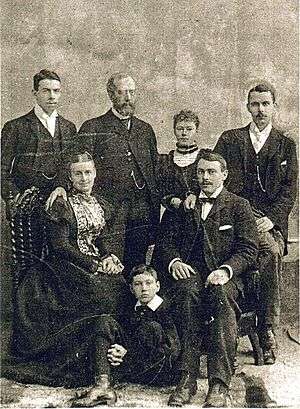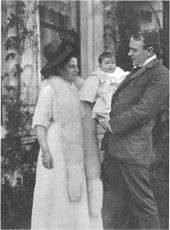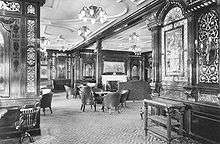Thomas Andrews
| Thomas Andrews | |
|---|---|
 | |
| Born |
Thomas Andrews, Jr. 7 February 1873 Comber, County Down, Ireland |
| Died |
15 April 1912 (aged 39) RMS Titanic, Atlantic Ocean |
| Nationality | Irish |
| Occupation | Shipbuilder |
| Known for | Head Designer – RMS Titanic |
| Spouse(s) | Helen Reilly Barbour (1908 – 1912) (his death) |
| Children | Elizabeth Law Barbour Andrews (1910-1973) |
Thomas Andrews, Jr. (7 February 1873 – 15 April 1912) was an Irish businessman and shipbuilder. He was managing director and head of the drafting department of the shipbuilding company Harland and Wolff in Belfast, Ireland. As the naval architect in charge of the plans for the ocean liner RMS Titanic, he was travelling on board that vessel during her maiden voyage when the ship hit an iceberg on 15 April 1912, and he died in the disaster.
Biography
Early life

Thomas Andrews was born at Ardara House, Comber, County Down, in Ireland, to The Rt. Hon. Thomas Andrews, a member of the Privy Council of Ireland, and Eliza Pirrie. Andrews was a Presbyterian of Scottish descent, and like his brother, considered himself British. His siblings included John Miller Andrews, the future Prime Minister of Northern Ireland, and Sir James Andrews, the future Lord Chief Justice of Northern Ireland. Thomas Andrews lived with his family in Ardara, Comber. In 1884, he began attending the Royal Belfast Academical Institution until 1889 when, at the age of sixteen, he began a premium apprenticeship at Harland and Wolff where his uncle, the Viscount Pirrie, was part owner.

Harland and Wolff
At Harland and Wolff, he began with three months in the joiners' shop, followed by a month in the cabinetmakers' and then a further two months working on the ships. The last eighteen months of his five-year apprenticeship were spent in the drawing office. In 1901, Andrews, after working his way up through the many departments of the company, became the manager of the construction works. That same year, he also became a member of the Institution of Naval Architects. In 1907, Andrews was appointed the managing director and head of the drafting department at Harland and Wolff. During his long years of apprenticeship, study, and work, Andrews had become well liked in the company and amongst the shipyard's employees.
On 24 June 1908, he married Helen Reilly Barbour, daughter of textile industrialist John Doherty Barbour and sister to Rt Hon Sir John Milne Barbour- known as "Milne". Their daughter, Elizabeth Law Barber Andrews (known by her initials, "ELBA"), was born on 27 November 1910. The couple lived at Dunallan, 20 Windsor Avenue, Belfast.[1][2] It is known that Andrews took Helen to view the RMS Titanic one night, shortly before Elizabeth was born. After Thomas's death, Helen remarried; she died 22 August 1966 in Northern Ireland and is buried in the Barbour family mausoleum at Lambeg.
RMS Titanic
In 1907, Andrews began to oversee the plans for a new superliner, the RMS Olympic for the White Star Line. The Olympic and its sister ship the Titanic, which began construction in 1909, were designed by William Pirrie and general manager Alexander Carlisle along with Andrews. As he had done for the other ships he had overseen, Andrews familiarised himself with every detail of the Olympic and Titanic, in order to ensure that they were in optimal working order. Andrews's suggestions that the ship have 46 lifeboats (instead of the 20 it ended up with) as well as a double hull and watertight bulkheads that went up to B deck, were overruled.
Andrews headed a group of Harland and Wolff workers who went on the maiden voyages of the ships built by the company (the guarantee group), to observe ship operations and spot any necessary improvements. The Titanic was no exception, so Andrews and the rest of his Harland and Wolff group travelled from Belfast to Southampton on Titanic for the beginning of her maiden voyage on 10 April 1912. During the voyage, Andrews took notes on various improvements he felt were needed, primarily cosmetic changes to various facilities. However, on 14 April, Andrews remarked to a friend that Titanic was "as nearly perfect as human brains can make her."
On 14 April at 11:40 PM, the Titanic struck an iceberg on the ship's starboard side. Andrews had been in his stateroom, planning changes he wanted to make to the ship, and barely noticed the collision. Captain Edward J. Smith had Andrews summoned to help examine the damage. Andrews and Captain Smith discussed the damage to the ship shortly after midnight, after Andrews had toured the damaged section of the ship and received several reports of the vessel's damage. Andrews determined that the first five of the ship's watertight compartments were rapidly flooding. Andrews knew that if more than four of the ship's compartments flooded, it would inevitably sink. He relayed this information to Captain Smith, stating that it was a 'mathematical certainty', and adding that in his opinion, the vessel had only about an hour before it completely sank. He also informed Smith of the severe shortage of lifeboats on board the ship.
As the evacuation of the Titanic began, Andrews tirelessly searched staterooms telling the passengers to put on lifebelts and go up on deck.[3] Several survivors testify to have met or spotted Andrews several times. Fully aware of the short time the ship had left and of the lack of lifeboat space for all passengers and crew, he continued to urge reluctant people into the lifeboats in the hope of filling them with as many people as possible.
Death

Andrews was reportedly last seen by John Stewart, a steward on the ship at approximately 2:10 a.m., ten minutes before the Titanic sank into the Atlantic. Andrews was standing alone in the first–class smoking room staring at a painting, Plymouth Harbour, above the fireplace, arms folded over his chest, his lifejacket lying on a nearby table.[4][5][6] The painting depicted the entrance to Plymouth Sound, which Titanic had been expected to visit on her return voyage.[7]
Although this has become one of the most famous legends of the sinking of the Titanic, this story, which was published in a 1912 book (Thomas Andrews: Shipbuilder by Shan Bullock) and therefore perpetuated, came from John Stewart, a steward on the ship who in fact left the ship in a lifeboat at approximately 1:40 a.m.[8]
There were testimonies of sightings of Andrews after that moment.[8] It appears that Andrews stayed in the smoking room for some time, then continued assisting with the evacuation.[8] At around 2:00 a.m., he was seen back on the boat deck. The crowd had begun to stir, but there were still women reluctant to leave the ship. To be heard and to draw attention to himself, Andrews waved his arms and announced to them in a loud voice.[9] Another reported sighting was of Andrews frantically throwing deck chairs into the ocean for passengers to cling to in the water. He then headed towards the bridge, perhaps in search of Captain Smith.[9] Andrews was last seen leaving the ship at the last moment. His body was never recovered.
On 19 April 1912, his father received a telegram from his mother's cousin, who had spoken with survivors in New York: "INTERVIEW TITANIC'S OFFICERS. ALL UNANIMOUS THAT ANDREWS HEROIC UNTO DEATH, THINKING ONLY SAFETY OTHERS. EXTEND HEARTFELT SYMPATHY TO ALL."
Legacy
Newspaper accounts of the disaster labelled Andrews a hero. Mary Sloan, a stewardess on the ship, whom Andrews persuaded to enter a lifeboat, later wrote in a letter: "Mr. Andrews met his fate like a true hero, realising the great danger, and gave up his life to save the women and children of the Titanic. They will find it hard to replace him." A short biography was produced within the year by Shan Bullock at the request of Sir Horace Plunkett, a member of Parliament, who felt that Andrews' life was worthy of being memorialised.
In his home town, Comber, one of the earliest and most substantial memorials for a single victim of the Titanic disaster was built. The Thomas Andrews Jr. Memorial Hall was opened in January 1914. The architects were Young and McKenzie with sculpted work by the artist Sophia Rosamond Praeger. The hall is now maintained by the South Eastern Education Board and used by The Andrews Memorial Primary School. An Ulster History Circle blue plaque is located on his house in Windsor Avenue, Belfast.
Today, the SS Nomadic is the sole surviving ship designed by Andrews.
Portrayals
- Patrick Macnee (1956; Kraft Television Theatre; A Night to Remember)
- Michael Goodliffe (1958; A Night to Remember)
- Geoffrey Whitehead (1979; S.O.S. Titanic; TV Movie)
- Victor Garber (1997; Titanic)
- Michael Cerveris (1997; Titanic; Broadway Musical)
- Vern Urich (1998; Titanic: Secrets Revealed; TV Documentary)
- Don Lynch (2003; Ghosts of the Abyss; Documentary)
- Damian O'Hare (2005; Titanic: Birth of a Legend; TV Documentary)
- Paul Mundell (2011; Curiosity Episode: "What Sank Titanic?")
- Stephen Campbell Moore (2012; Titanic; TV series/3 episodes)
- Billy Carter (2012; Titanic: Blood and Steel; TV series/12 episodes)
- Nick Danan (2012; The Titanic Boys; Stage Production- Grand Opera House, Belfast)
- Stephen Hogan (2012; Saving The Titanic; PBS TV Movie)
- Robert Bagdon (2013; Belfast Air; Short Film)
- Kazuki Kato (2015; "Titanic the musical"; Japanese Musical directed by Tom Sutherland)
References
- ↑ NationalArchives.ie
- ↑ Ulster History Cycle
- ↑ (Mark Chirnside 2004, p. 163)
- ↑ Eaton & Haas 1994, p. 155.
- ↑ (Walter Lord 1998, p. 113)
- ↑ (Mark Chirnside 2004, p. 177)
- ↑ The painting is often incorrectly shown on television and in movies as depicting the entrance to New York Harbor.
- 1 2 3 ON A SEA OF GLASS: THE LIFE & LOSS OF THE RMS TITANIC" by Tad Fitch, J. Kent Layton & Bill Wormstedt. Amberley Books, March 2012. pp 321-323
- 1 2 (English) « The sinking of the Titanic », Thomas Andrews Shipbuilder. Consulté le 21 avril 2011
- M. A. Kribble. "Thomas Andrews: Builder of the Ship of Dreams". Thomas Andrews: Builder of the Ship of Dreams. Archived from the original on 2 February 2003. Retrieved 9 July 2005.
External links
| Wikimedia Commons has media related to Thomas Andrews. |
- Thomas Andrews on Titanic-Titanic.com
- Encyclopedia Titanica Biography of Thomas Andrews
- LibraryIreland.com, "Thomas Andrews Shipbuilder", a 1912 biography of Thomas Andrews
- Thomas Andrews, Jr at Find a Grave